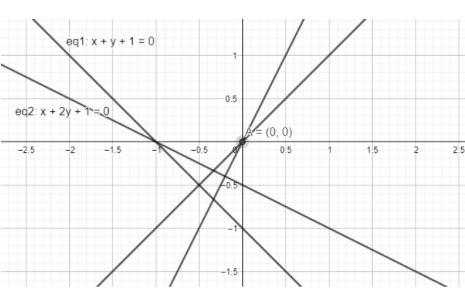
In $x+y+1=0$ and $x+2y+1=0$ are angle bisector of lines ${{L}_{1}}$ and ${{L}_{2}}$ and point $\left( 0,0 \right)$ lies on ${{L}_{1}}$ , then acute angle bisector of ${{L}_{1}}$ and ${{L}_{2}}$ is,
(a) $x+y-1=0$
(b) $x+y+1=0$
(c) $x+2y+1=0$
(d) Data insufficient
Answer
586.5k+ views
Hint: First find the points A, B, C by intersection of sides given in the question. So given an internal angular bisector, the bisector bisects the angle into 2 equal halves hence, it divides the side opposite into 2 parts with ratio of corresponding sides. Equation of angular bisector of two equation of line $ax+by+c=0,dx+ey+f=0$ is given by
$\dfrac{ax+by+c}{\sqrt{{{a}^{2}}+{{b}^{2}}}}=\pm \dfrac{dx+ey+f}{\sqrt{{{d}^{2}}+{{e}^{2}}}}$
These 2 lines become the equations of bisectors.
Complete step-by-step answer:
If two lines from an angle then they have 2 angles bisectors because between 2 lines there are 2 angles possible which are acute and obtuse. So, the 2 lines bisecting these 2 angles between lines $ax+by+c=0,dx+ey+f=0$ are given by
$\dfrac{ax+by+c}{\sqrt{{{a}^{2}}+{{b}^{2}}}}=\pm \dfrac{dx+ey+f}{\sqrt{{{d}^{2}}+{{e}^{2}}}}$
So, the symbol plus or minus denotes 2 equations of bisectors. Out of both any of them may be acute and may be obtuse if one is acute the other is obtuse and vice versa.
The both given bisectors are \[x+y+1=0\] , $x+2y+1=0$ , we need to find out the acute angle bisector from these both.

In the figure we are representing 2 lines and perpendiculars from A. The reason we plotted perpendiculars will be understood in the following solution.
As given \[\left( 0,0 \right)\] lies on \[{{L}_{1}}\] . we will find the perpendicular distance of \[\left( 0,0 \right)\] to both the lines.
Perpendicular distance of a line \[ax+by+c=0\] from \[\left( h,k \right)\] :
Let the distance be represented by d (for temporary)
\[d=\left| \dfrac{ah+bk+c}{\sqrt{{{a}^{2}}+{{b}^{2}}}} \right|\]
Perpendicular distance of the line \[x+y+1=0\] from \[\left( 0,0 \right)\] .
Let the distance be represented by a.
\[a=\left| \dfrac{0+0+1}{\sqrt{{{1}^{2}}+{{1}^{2}}}} \right|=\dfrac{1}{\sqrt{2}}\]
By simplifying we get the value of a to be $\dfrac{1}{\sqrt{2}}$. Perpendicular distance of the line $x+2y+1=0$ from \[\left( 0,0 \right)\] .
Let the distance be represented by b.
$b=\left| \dfrac{0+0+1}{\sqrt{{{1}^{2}}+{{2}^{2}}}} \right|=\dfrac{1}{\sqrt{5}}$
By simplifying we get b to be $\dfrac{1}{\sqrt{5}}$ .
We have $a$$<$$b$ . So, the sin of angle made will be greater in case of a. So, it will be obtuse. The line $x+2y+1=0$ will be acute. Option (c) is correct.
Note:Be careful while relating the distance to angle. Here, it is opposite/hypotenuse. Since the value of sine of angle is directly proportional to distance. Use the above relation properly as the sine of angle we get will be perpendicular from A / hypotenuse. As hypotenuse is the same we can relate directly to the perpendicular distance.
$\dfrac{ax+by+c}{\sqrt{{{a}^{2}}+{{b}^{2}}}}=\pm \dfrac{dx+ey+f}{\sqrt{{{d}^{2}}+{{e}^{2}}}}$
These 2 lines become the equations of bisectors.
Complete step-by-step answer:
If two lines from an angle then they have 2 angles bisectors because between 2 lines there are 2 angles possible which are acute and obtuse. So, the 2 lines bisecting these 2 angles between lines $ax+by+c=0,dx+ey+f=0$ are given by
$\dfrac{ax+by+c}{\sqrt{{{a}^{2}}+{{b}^{2}}}}=\pm \dfrac{dx+ey+f}{\sqrt{{{d}^{2}}+{{e}^{2}}}}$
So, the symbol plus or minus denotes 2 equations of bisectors. Out of both any of them may be acute and may be obtuse if one is acute the other is obtuse and vice versa.
The both given bisectors are \[x+y+1=0\] , $x+2y+1=0$ , we need to find out the acute angle bisector from these both.

In the figure we are representing 2 lines and perpendiculars from A. The reason we plotted perpendiculars will be understood in the following solution.
As given \[\left( 0,0 \right)\] lies on \[{{L}_{1}}\] . we will find the perpendicular distance of \[\left( 0,0 \right)\] to both the lines.
Perpendicular distance of a line \[ax+by+c=0\] from \[\left( h,k \right)\] :
Let the distance be represented by d (for temporary)
\[d=\left| \dfrac{ah+bk+c}{\sqrt{{{a}^{2}}+{{b}^{2}}}} \right|\]
Perpendicular distance of the line \[x+y+1=0\] from \[\left( 0,0 \right)\] .
Let the distance be represented by a.
\[a=\left| \dfrac{0+0+1}{\sqrt{{{1}^{2}}+{{1}^{2}}}} \right|=\dfrac{1}{\sqrt{2}}\]
By simplifying we get the value of a to be $\dfrac{1}{\sqrt{2}}$. Perpendicular distance of the line $x+2y+1=0$ from \[\left( 0,0 \right)\] .
Let the distance be represented by b.
$b=\left| \dfrac{0+0+1}{\sqrt{{{1}^{2}}+{{2}^{2}}}} \right|=\dfrac{1}{\sqrt{5}}$
By simplifying we get b to be $\dfrac{1}{\sqrt{5}}$ .
We have $a$$<$$b$ . So, the sin of angle made will be greater in case of a. So, it will be obtuse. The line $x+2y+1=0$ will be acute. Option (c) is correct.
Note:Be careful while relating the distance to angle. Here, it is opposite/hypotenuse. Since the value of sine of angle is directly proportional to distance. Use the above relation properly as the sine of angle we get will be perpendicular from A / hypotenuse. As hypotenuse is the same we can relate directly to the perpendicular distance.
Recently Updated Pages
Master Class 11 Accountancy: Engaging Questions & Answers for Success

Master Class 11 Science: Engaging Questions & Answers for Success

Master Class 11 Business Studies: Engaging Questions & Answers for Success

Master Class 11 English: Engaging Questions & Answers for Success

Master Class 11 Computer Science: Engaging Questions & Answers for Success

Master Class 9 General Knowledge: Engaging Questions & Answers for Success

Trending doubts
Which are the Top 10 Largest Countries of the World?

Draw a labelled sketch of the human eye class 12 physics CBSE

State the principle of an ac generator and explain class 12 physics CBSE

Differentiate between insitu conservation and exsitu class 12 biology CBSE

Sketch the electric field lines in case of an electric class 12 physics CBSE

Give 10 examples of unisexual and bisexual flowers




